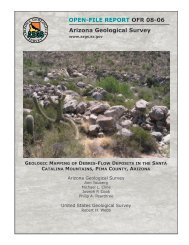geothermal resource potential of the safford-san simon basin, arizona
geothermal resource potential of the safford-san simon basin, arizona
geothermal resource potential of the safford-san simon basin, arizona
You also want an ePaper? Increase the reach of your titles
YUMPU automatically turns print PDFs into web optimized ePapers that Google loves.
sidence that was created by ground water removal.<br />
Additional leveling data<br />
reported by Holzer (1980) show up to 1.25 m <strong>of</strong> subsidence since 1972 over<br />
<strong>the</strong> graben, but no net uplift over <strong>the</strong> horst.<br />
However, Holzer (1980) pointed<br />
out that aerial photographs taken in 1935 over <strong>the</strong> Bowie area show many polygonal<br />
earth fissures over <strong>the</strong> horst. No significant ground water withdrawal occurred<br />
before 1935; <strong>the</strong>refore, <strong>the</strong>se fissures may not be subsidence related.<br />
As to<br />
whe<strong>the</strong>r or not <strong>the</strong> 1935 earth fissures are definitely related to uplift <strong>of</strong><br />
<strong>the</strong> horst, it is speculative, because earth fissuring in many areas <strong>of</strong> sou<strong>the</strong>astern<br />
Arizona is reported by DuBois and Smith (1981) during <strong>the</strong> 1887 Sonoran<br />
earthquake.<br />
Therefore, <strong>the</strong> fissures seen in 1935 photographs may have originated<br />
during <strong>the</strong> Sonoran earthquake and may not indicate local tectonism.<br />
Conclusion<br />
A spatial coincidence <strong>of</strong> wells, producing sodium bicarbonate water with<br />
low magnesium, high Na-K-Ca geo<strong>the</strong>rmometers, and an apparent structural intersection,<br />
which is inferred from ground water falls and gravity data, support<br />
<strong>the</strong> hypo<strong>the</strong>sis that a deep (>2 km)<br />
moderate-temperature <strong>geo<strong>the</strong>rmal</strong> reservoir<br />
o<br />
(~124 C) occurs south <strong>of</strong> Bowie. Well D-13-28-l5DCC, which has <strong>the</strong> highest Na-<br />
K-Ca temperature (124°C), is <strong>the</strong> most anomalous well from a temperature and<br />
depth standpoint.<br />
o<br />
This well, 145 m deep, has a discharge temperature <strong>of</strong> 35 C<br />
and an estimated average temperature gradient <strong>of</strong> l24°C/km.<br />
All o<strong>the</strong>r wells in<br />
<strong>the</strong> area have estimated temperature gradients between 30 and 80 o C/km and a mean<br />
temperature gradient <strong>of</strong> 49 0 C/km.<br />
Fur<strong>the</strong>r studies are advised before drilling a deep test into this possible<br />
deep reservoir.<br />
Heat flow studies and geochemical modeling are needed to site<br />
a deep hole.<br />
A shallow «600 m) <strong>geo<strong>the</strong>rmal</strong> <strong>resource</strong> does exist at B~wie and it has a<br />
reservoir temperature ranging between 35 and 45 0 C.<br />
The <strong>geo<strong>the</strong>rmal</strong> water has<br />
86

















